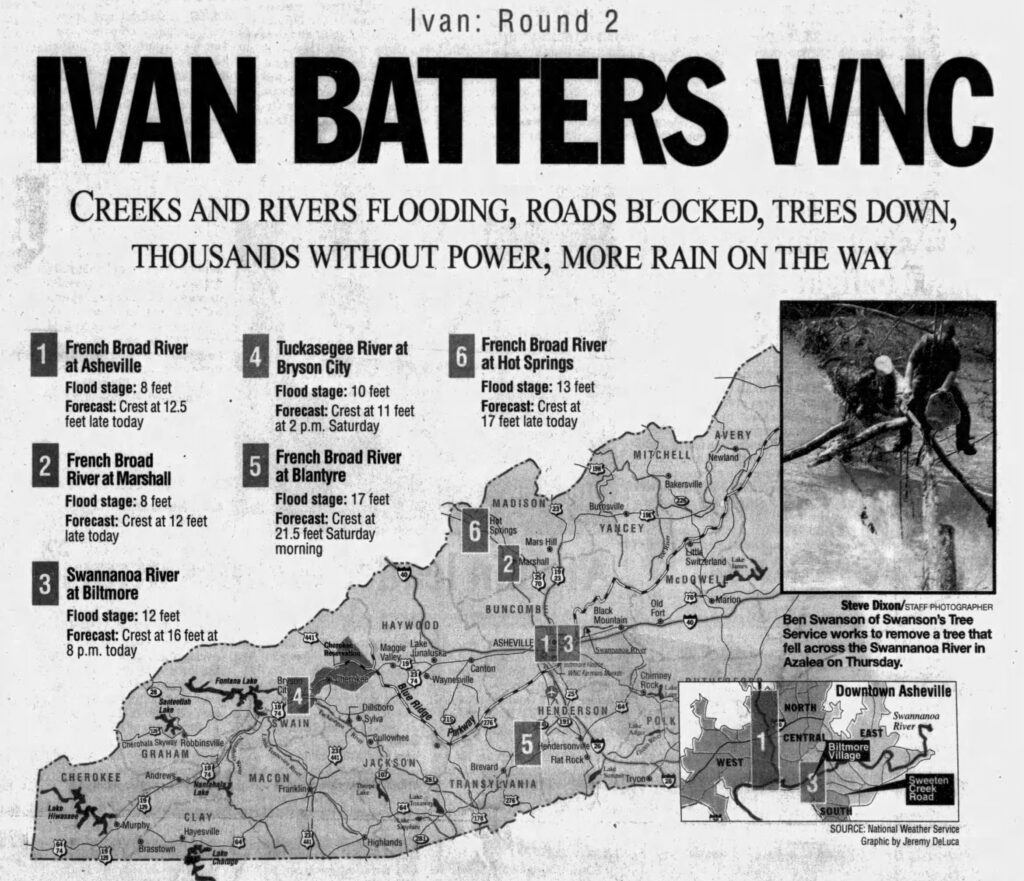N.C. Cooperative Extension, Buncombe County Center : The 2000s
go.ncsu.edu/readext?1093411
en Español / em Português
El inglés es el idioma de control de esta página. En la medida en que haya algún conflicto entre la traducción al inglés y la traducción, el inglés prevalece.
Al hacer clic en el enlace de traducción se activa un servicio de traducción gratuito para convertir la página al español. Al igual que con cualquier traducción por Internet, la conversión no es sensible al contexto y puede que no traduzca el texto en su significado original. NC State Extension no garantiza la exactitud del texto traducido. Por favor, tenga en cuenta que algunas aplicaciones y/o servicios pueden no funcionar como se espera cuando se traducen.
Português
Inglês é o idioma de controle desta página. Na medida que haja algum conflito entre o texto original em Inglês e a tradução, o Inglês prevalece.
Ao clicar no link de tradução, um serviço gratuito de tradução será ativado para converter a página para o Português. Como em qualquer tradução pela internet, a conversão não é sensivel ao contexto e pode não ocorrer a tradução para o significado orginal. O serviço de Extensão da Carolina do Norte (NC State Extension) não garante a exatidão do texto traduzido. Por favor, observe que algumas funções ou serviços podem não funcionar como esperado após a tradução.
English
English is the controlling language of this page. To the extent there is any conflict between the English text and the translation, English controls.
Clicking on the translation link activates a free translation service to convert the page to Spanish. As with any Internet translation, the conversion is not context-sensitive and may not translate the text to its original meaning. NC State Extension does not guarantee the accuracy of the translated text. Please note that some applications and/or services may not function as expected when translated.
Collapse ▲The 2000s for the American farmer was a decade of technological advancement and change. The number of farms nationwide continued to decline while genetically modified crops emerged as a widely debated topic among farmers and consumers both. North Carolina farmers, in particular, faced a seismic shift in the first half of the decade as the government-supported tobacco quota system ceased, leaving many farmers exploring alternative crops and diversification to continue their farming businesses.
2000
The North Carolina Tobacco Trust Fund Commission (NCTTFC) is created by the NC General Assembly to serve as one of three entities to distribute the state’s funds received from the Master Settlement Agreement of 1998. Still in existence, it remains a vital part of our state’s economic transition. Their ongoing mission is to provide financial grants and support to individuals impacted by the tobacco economy through new job training, local market support, farm product promotion, and farm safety improvements.
For more information on the NC Tobacco Trust Fund Commission, please visit their website at tobaccotrustfund.org.
Newly formed local non-profit organization ASAP (Appalachian Sustainable Agriculture Project) begins its mission of helping burley tobacco farms and farmers transition to producing alternative crops using healthy and sustainable methods.
Twenty five years later, ASAP continues its mission of supporting local agriculture, linking farmers to markets, hosting a yearly farm tour, and building connections to local food. Their yearly Local Food Guide features area farms, farmers markets, restaurants, and recipes in the Appalachian Mountains region from Virginia to Georgia. Find out more on their website at: asapconnections.org.
May 24 – The Buncombe County office of N.C. Cooperative Extension moves to its new location at 94 Coxe Avenue in downtown Asheville. Prior to this, the office spent 23 years in the Allen Center on College Street (from 1977 to 2000). From 1926 to 1977, the office was housed on the third floor of the Buncombe County courthouse.
2001
January 25 – Asheville’s two tobacco warehouses close out their season selling 5,325,887 pounds of tobacco. This figure was down from more than 6 million pounds sold in the previous season. Despite allotments being cut by 45%, growers received an average of $1.98 per pound.
June 16 – As traditional farming of tobacco and dairy and beef cattle begins to decline, many farmers start looking for other ways to keep their farm businesses viable. Agri-tourism emerges in the area with farms beginning to offer corn mazes, hay rides, U-pick options, music, farm-to-table dinners, events, and more.
Today, agritourism plays a substantial role in keeping farms and rural communities economically viable. Detailed information on agritourism can be found on the N.C. Cooperative Extension website at tourism.ces.ncsu.edu.
November 11 – To give burley tobacco farmers an alternative to selling their crops under contract with a specific tobacco company, a program is launched to eliminate the warehouse and grading fees at Asheville’s two remaining burley markets. This move allows farmers to sell their crop at the auction house for the best price, instead of the pre-determined price of their contract. It is an effort to keep the local tobacco business flourishing despite foreign competition and uncertainty around the diminishing federal quota system, a program introduced in the 1930s to stabilize tobacco prices.
The Western North Carolina Agricultural Options Program is created. Still in service today, WNC Ag Options provides financial grants and technical assistance to farmers working in new agricultural markets. Their mission of supporting sustainable farming communities across the mountains is evident in their funding of projects that strengthen both local agriculture and individual farming ventures.
2004
September 7 – Hurricane Frances, the first of two major hurricanes to hit Asheville and Western North Carolina in September, 2004, causes major flooding in the area.
September 16 – Hurricane Ivan strikes western North Carolina, adding additional damage to that caused by Hurricane Frances.
October 22 – After years of debate and decline, the Fair and Equitable Tobacco Reform Act officially ends the 1938 Agricultural Adjustment Act which established tobacco quotas. Buyout payments are to be paid to tobacco growers over the next 10 years. Some 437,000 people become eligible for the buyout payments. Owners of tobacco allotments will receive $7 per pound for quota owned and renters of quotas will receive $3 per pound, based on 2002 figures. This buyout removed the support price for the crop, making the crop economically riskier to grow and prompted many to retire from the business or explore alternative crops.
December 13 – The Western Carolina Livestock Market, on Craven Street, closes. Operating from April 9, 1953 until December 13, 2004, it served the WNC region for 51 years. The area is now home to New Belgium Brewery.
2006
June 6 – As the decade progressed, the tobacco industry continued to transition from the effects of the buyout.
2007
The 2007 Census of Agriculture lists:
1,077 farms in Buncombe County consisting of 72,087 acres of farmland.
In comparison, the 2002 Census of Agriculture lists:
1,192 farms in Buncombe County consisting of 94,934 acres of farmland, indicating a loss of 115 farms and 22,847 acres of land used as farmland.
A number of factors can lead to the loss of farmland, and while every farmer’s situation is unique, resources are available through North Carolina Cooperative Extension and Buncombe County to help with farm succession, transfer, and preservation.
N.C. Cooperative Extension: Farm Succession and Transfer
Buncombe County Farmland Preservation Program
2009
November 11 – 2009 marks the 100th anniversary of the 4H Club programs in North Carolina.
4H Programs continue to provide opportunities for youth ages 5-19 to learn new skills in areas such as STEM, agriculture, community engagement, healthy living, and more. For more information on 4H Clubs in Buncombe County and how children and adults can be involved, see our website at go.ncsu.edu/buncombe4h.
As the decade drew to a close, the effects of the tobacco buyout, which characterized much of the 2000s, in addition to the closing of our area’s regional livestock market, led to a transition from tobacco and traditional farming. Some farmers left the business entirely while others diversified their products or implemented new business models such as Community Supported Agriculture shares, or CSAs, to bolster sales. These changes laid the groundwork for the 2010s, a decade that ushered in a burgeoning local food scene with farm to table restaurants, new tailgate markets, and the brewing industry for which our area has become well known.
Join us next month as we explore the 2010s and the changes and events in agriculture and N.C. Cooperative Extension work in Buncombe County.
To read about past decades, check out our “History of N.C. Cooperative Extension, Buncombe County Center” webpage.
Sources
“4-H Homecoming.” News Record & Sentinel, 11 Nov. 2009, p. 8, Accessed 29 Sept. 2025.
“ASAP – Local Food. Strong Farms. Healthy Communities.” Asapconnections.Org, ASAP, asapconnections.org/. Accessed 25 Sept. 2025.
Ball, Julie. “Burley Farmers Gain Sales Choice.” The Asheville Citizen Times, 11 Nov. 2001, p. D 1-D 3, Accessed 25 Sept. 2025.
Boyle, John. “Burley Tobacco Center Set to Open.” The Asheville Citizen Times, 14 Nov. 2004, p. B 1-B 2, Accessed 25 Sept. 2025.
Boyle, John. “Historic Day for N.C. Tobacco Farmers.” The Asheville Citizen Times, 12 Oct. 2004, p. A 1-A 4, Accessed 25 Sept. 2025.
Boyle, John. “Old Stockyard’s Future: Flea Market, Housing?” The Asheville Citizen Times, 13 June 2006, pp. A1–A6, Accessed 29 Sept. 2025.
Boyle, John. “WNC Tobacco Farming Faces Troubling Trend: Growers Getting Out.” The Asheville Citizen Times, 6 June 2006, pp. 1–3, Accessed 29 Sept. 2025.
Holmes, Jennifer. “Cooperative Extension Gets Home of Its Own.” The Asheville Citizen Times, 15 May 2000, p. B 1, Accessed 25 Sept. 2025.
Holmes, Jennifer. “Extension Service to Host Open House in New Home.” The Asheville Citizen Times, 16 Nov. 2000, p. D3, Accessed 25 Sept. 2025.
Reid, Tim. “Asheville Tobacco Market Ends Solid Season.” The Asheville Citizen Times, 25 Jan. 2001, p. B5, Accessed 25 Sept. 2025.












